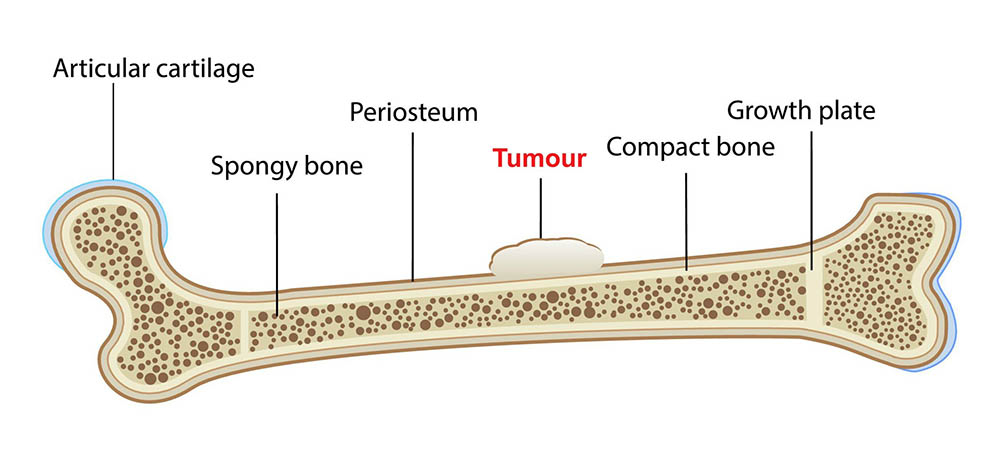Bone cancer
What is bone cancer?
Bone cancer can grow in any of the 200 bones in your body, although it’s more common in the large bones in your arms or legs. It can affect both adults and children.
Bone cancer can be either primary or secondary. Each one is treated differently.
Primary bone cancer is a rare cancer, affecting about 250 Australians a year. It begins in the bones. The cancer cells can grow on the surface of the bone, in its outer layer or in the centre. It gradually destroys the healthy bone and it can spread to other parts of the body. Primary bone cancer is sometimes called osteosarcoma or bone sarcoma.

Secondary bone cancer is cancer that started somewhere else in the body and spread to the bones. It is more common than primary bone cancer. Any type of cancer can spread to the bone, but the most common types are breast, lung, kidney, thyroid and prostate cancers.
Secondary bone cancers are usually found in the hip, thighbone, shoulder or spine.
What are the types of bone cancer?
There are many different types of primary bone cancer. The most common is osteosarcoma, which usually affects teenagers or young adults and is found at the ends of the long bones.
The second most common type is chondrosarcoma, which grows in the bone cartilage at the ends of the bones. It’s usually seen in people over 40 and is found in the pelvis, shoulder, knee, spine, upper parts of the arms or legs, or the ribs.
Ewing sarcomas are tumours that grow in the bone or soft tissues around the bone. They’re most often seen in young teenagers and can grow quickly. They are usually found in the middle of the hip bones, the rib cage or on the shoulder blades.
Some other types of cancer grow in the bone marrow inside the bones, including leukaemia, multiple myeloma and lymphoma. These are not treated as bone cancers, but they do also affect the bones.
What are the symptoms of bone cancer?
The most common symptoms of bone cancer are pain in the bones, usually at night time or after physical activity. You might also notice a swelling over the bone.
Other symptoms are:
- stiff bones
- a bone that breaks for no reason
- problems moving, such as an unexplained limp
- losing feeling in the limb
- losing weight unexpectedly
- feeling very tired
All of these symptoms could be due to something other than bone cancer. But if you are worried, tell your doctor.
What causes bone cancer?
We don’t fully understand why some people develop primary bone cancer, but some things can increase your risk:
- having a bone disease such as Paget’s disease of the bone
- having previously had high doses of radiation therapy for another cancer
- having a problem with your genes, or having a close relative who had bone cancer
How is bone cancer diagnosed?
Your doctor will examine you and order some tests. These might include a bone scan, or an x-ray, CT, MRI or PET scan.
Your doctor may remove a small sample of tissue to be examined in a laboratory (a biopsy) to make a firm diagnosis. This will either be done with a small needle inserted into the tumour or during surgery.
How is bone cancer treated?
The type of treatment will depend on the type of bone cancer and how far it has spread (known as its stage). It usually involves surgery to remove the tumour, followed by chemotherapy and/or radiotherapy to kill any cancer cells.
If you have surgery, your surgeon will aim to remove the cancer and also make sure you can still use the affected part of your body. Usually the operation will remove the part of the bone with the cancer and leave the rest of the bone in place. The gap will be filled with artificial bone or with a healthy piece of bone taken from another part of your body. This is called a bone graft.
In about 1 in 10 cases, the whole limb must be removed. Afterward an artificial limb, called a prosthesis, may be fitted.
If it is not possible to operate — for example, in some parts of the spine — there may be other treatments available.
Living with bone cancer
Many people who have bone cancer treatment go into remission. That means their symptoms get better or disappear. But you will still need to go for regular checks with your specialist and have ongoing tests.
If you had part of the bone removed, the remaining limb might look and feel different. A physiotherapist will work with you to strengthen the limb and help it work better.
If you had an amputation, you will need to wait for the wound to heal and the swelling to go down before you can have an artificial limb fitted. Then you will need rehabilitation to learn how to use your new limb. Some people prefer to use a wheelchair. There are different schemes to help you pay for your artificial limb. Visit Limbs4Life for more information.
After you have been treated for cancer, it is normal to feel afraid that the cancer will return. If you are struggling, it is important to seek support from your doctor, a therapist or other people who have gone through cancer.


